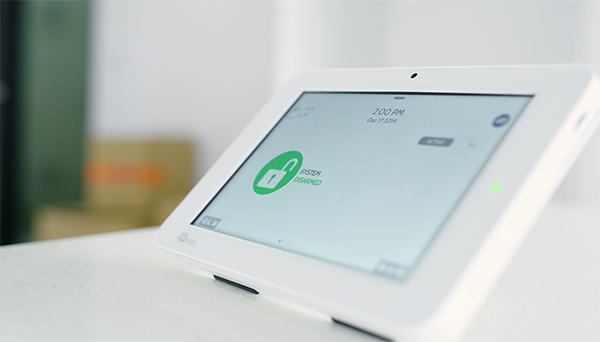As each home has its individual security risks, understanding these is key to determining where to place your security cameras.
In 2020-21 approximately 171,600 homes were broken into in Australia, with money, jewellery, clothing and bicycles or sporting equipment1 the most sought-after items.
When it comes to deterring burglars, it pays to be vigilant as most intruders will look for easy entry points that are low-impact and offer a quick and convenient get away, such as a low-level unlocked window or door.
ADT has a range of indoor and outdoor cameras that allow you to monitor every area of the home with your specific security needs in mind.
Placement of outdoor cameras
Outdoor security cameras are a home’s first line of defence. Whether your intention is to deter burglars from attempting a break-in or to monitor your property for movement while you’re away, these security camera placement tips will have you covered.
- Survey the entire perimeter of your property, taking note of the crawl spaces, entry points, hiding spots and assets at risk.
- Consider the number of cameras required by identifying visible locations that will act as a ‘deterrent’ to would-be burglars while ensuring they can be adequately viewed should footage of a break-in need to be assessed for identification purposes.
- Don’t overlook non-conventional entry points, as a burglar may avoid front doors and large windows in favour of an upper-level balcony or awning as alternate opportunities to gain entry.
- Strategically positioned cameras that offer an elevated vantage point can maximise coverage across an entire yard or down the side of a house.
- Protect your other assets by installing security cameras to monitor pools, garages, driveways, sheds and carports.
Placement of indoor security cameras
Indoor cameras can play an important role in supporting a home security system as well as provide homeowners with added lifestyle benefits by monitor indoor movement. They can not only be used to identify burglars, but can also let you check in with your family, pets or contractors through a live 24/7 feed while you’re away.
Here are some tips to help you get the most out of indoor security cameras.
- Monitor potential ‘hot spots’ where burglars are likely to gravitate towards, such as liquor cabinets, home offices, trophy/displays, jewellery boxes, etc.
- Consider placing cameras in common areas that provide opportunities to monitor pets or check in on family members. Some households may also wish to keep an eye on vulnerable occupants who may be elderly or have limited mobility by monitoring areas such as stairs.
- Visible cameras inside the home can also be a powerful deterrent should a burglar gain entry to a home, by alerting them that they are under surveillance. Indoor cameras can be placed in entrance foyers, hallways and other visible areas.
- Positioning cameras up high on shelves or tall furniture will not only protect them from interference but can also widen the field of view.
How many security cameras does your home need?
The number of security cameras you need for your home depends on various factors, such as the size of your property, the layout of your home, your security goals, and your budget.
You need to install security cameras that give full coverage over all entry points (such as front and back doors), as well as the driveway, backyard, and other vulnerable areas.
Proper home security camera placement is paramount to their effectiveness. If your cameras are placed incorrectly, they may miss important events around your home. That’s why ADT provides a free security assessment of your premises, our licensed professionals will build your security solution while keeping your specific needs and requirements in mind.
Guidelines and privacy considerations for the placement of security cameras
The Office of the Australian Information Commissioner (OAIC) states that Australia’s Privacy Act does not cover security cameras operated by an individual acting in a private capacity, but state or territory security camera placement laws may apply.
For example, in New South Wales Section 8 of the Surveillance Devices Act 2007 states that it is an offence to install, use or maintain a security camera on a property or vehicle without the owner’s consent2.
Section 227A of the Criminal Code in Queensland and the Surveillance Devices Act 1999 in Victoria similarly state that it is an offence to record private activity without permission3, or record people in places where they would expect privacy such as a bedroom, bathroom, or changeroom4.
It is important to follow security camera placement best practices, which includes acting ethically and courteously when installing security cameras.
Depending on where you live, you could be vulnerable to complaints if:
- the area being monitored is one where someone would expect to have privacy
- your home security camera system prevents others from enjoying their property
- your home security camera system is seen to be a spiteful response to a neighbourhood dispute involving threatening behaviour.
For more security tips and solutions, visit our website or call 131 238
1 https://www.abs.gov.au/statistics/people/crime-and-justice/crime-victimisation-australia/latest-release
2 https://legislation.nsw.gov.au/view/whole/html/inforce/current/act-2007-064#sec.8
3 https://www.legislation.vic.gov.au/in-force/acts/surveillance-devices-act-1999/042
4 https://www.oic.qld.gov.au/guidelines/for-community-members/Information-sheets-privacy-principles/camera-surveillance,-video,-and-audio-recording-a-community-guide





